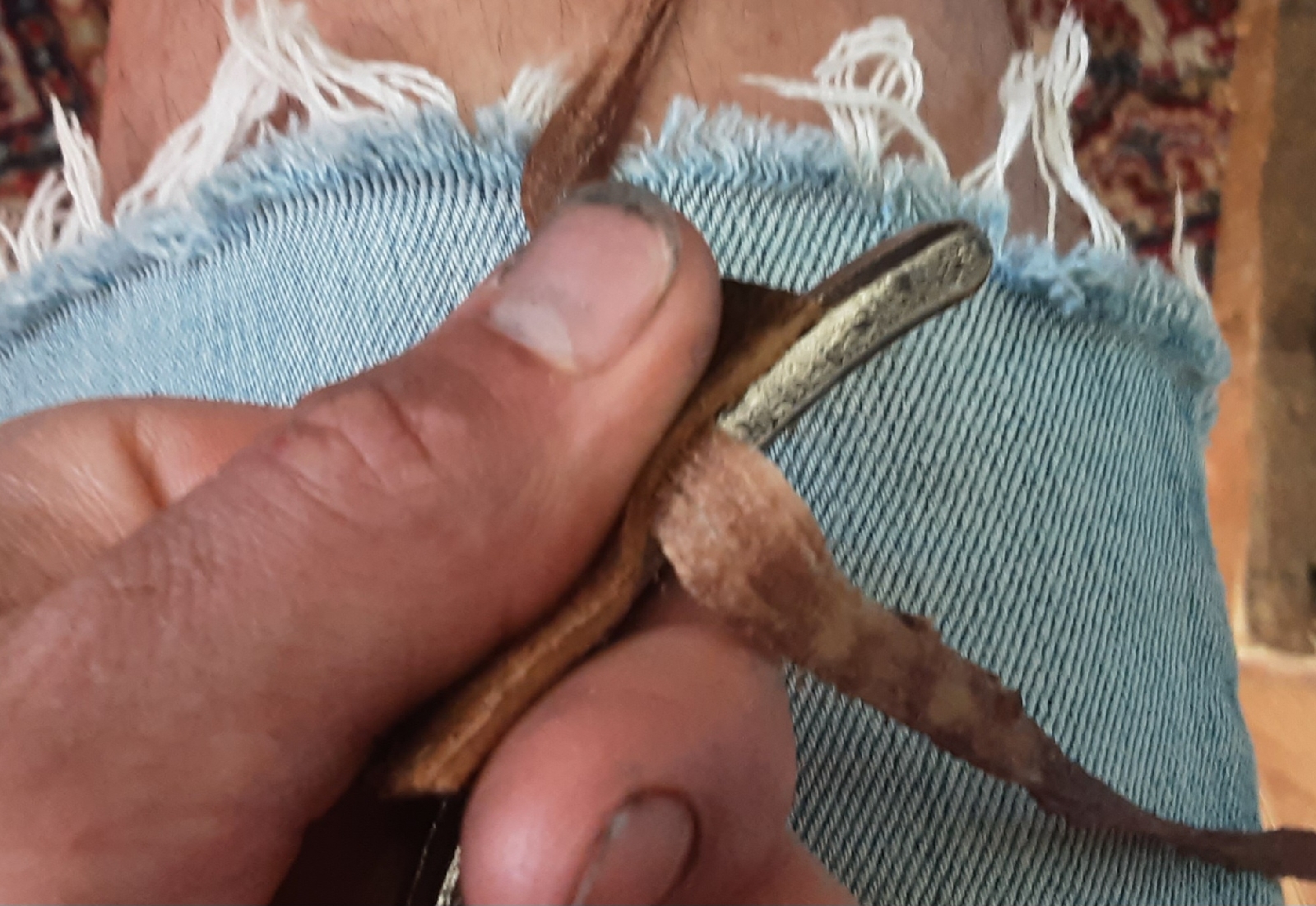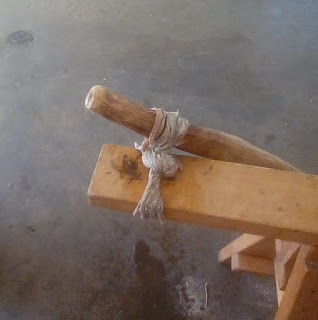Splitting Sinews
When making cord I use sinew – its strong and easy to work with. Cord from sinew starts with proper butchering. An awl is a helpful tool to use when splitting and processing meat and sinews.
Store the sinew dry; then when you need them, soak the appropriate amount of strands in water.
Cut away tangles, bunches and knots at the tips and cook these for a broth and to add nutritious flavour to slow cook soups.
With an awl, when you find a sinew bundle is too thick, poke it midway in the length of the bundle, and pull down creating a separation hole which is just big enough to fit fingers through; then with those fingers pull the two sides apart until the sinew bundle has split lengwise.
This method works for making sinew for strings, but for bow making, the sinew must be very fine. I havent had much experience with sinew bow making, but experience has proven that hammering tendon, as is so common, can damage the integrity of strands and can also cut them.
Store the sinew dry; then when you need them, soak the appropriate amount of strands in water.
Wet the remaining meat to more easily remover it; gently bite the strip and slide it through your teeth to clean the strands and ready them for use.
A bone or metal awl or will further split tendon into manigable stands. Bother with long sources of sinew: the shoulder muscle, the back, inner spine, and the long leg tendons.
Cut away tangles, bunches and knots at the tips and cook these for a broth and to add nutritious flavour to slow cook soups.
Dont bother with strips that are short - cook in stead.
The long blackstrap sinew and huge, properly harvested leg sinews are good, but I started by using relativly horrid jerky strands which meant short poorly harvested bits from sloppy or hasty made died meat.
To remover blackstrap sinew, leave strap in bone. Remove covering silver skin, forward top muscle (the one that lies on the big long backstrap, near the spine bone and extends from the neck to the mid back. Where the strap sinew begines at the front end, slide a knife between strap and sinew on the surface. Lift this up to find the beginning of the long back sinew; grab the flap, and pull down as far as it will travel. You may need to use a knife to gently cut when it stalls to continue the harvest.
The long blackstrap sinew and huge, properly harvested leg sinews are good, but I started by using relativly horrid jerky strands which meant short poorly harvested bits from sloppy or hasty made died meat.
 |
| Shoulder sinew found on the "big" side of the shoulder blade bone, are straight split able strands. |
To remover blackstrap sinew, leave strap in bone. Remove covering silver skin, forward top muscle (the one that lies on the big long backstrap, near the spine bone and extends from the neck to the mid back. Where the strap sinew begines at the front end, slide a knife between strap and sinew on the surface. Lift this up to find the beginning of the long back sinew; grab the flap, and pull down as far as it will travel. You may need to use a knife to gently cut when it stalls to continue the harvest.
Dehydrate the sinew strap with whatever little meat is still on. Also, you can find long sinew strands between the spine bones and the large back muscle.
Leg sinew is harvested whole. Removing the lower meatless leg tendon and upper, what would be "calf" muscle sections as one. The blade comes in minimally to cut where the sinews join at the foot, the sides of one another, and where they attach directly to the ends of the bone. An awl or back of a knife can start a separation of the muscless, brute strength pulling appart with shoulders, followed by scraping the meat off the area of sinew holding the muscle - of course saving the meat for drying and tiny bits for the birds or ground; this process can take on many variations, but it must be done without touching the meat too much as if it is later dried, touching will cause bacteria to spread. If the muscle packets are thin enough, just hang it with the sinew and process later as time can be important. The easiest way is to just get the sinews off with the muscle and dried (if drying the meat) and process the sinews later. Sometimes its easer to cut where the long leg tendon meets the muscle meat, in which case you would lose a few inches.
Leg sinew is harvested whole. Removing the lower meatless leg tendon and upper, what would be "calf" muscle sections as one. The blade comes in minimally to cut where the sinews join at the foot, the sides of one another, and where they attach directly to the ends of the bone. An awl or back of a knife can start a separation of the muscless, brute strength pulling appart with shoulders, followed by scraping the meat off the area of sinew holding the muscle - of course saving the meat for drying and tiny bits for the birds or ground; this process can take on many variations, but it must be done without touching the meat too much as if it is later dried, touching will cause bacteria to spread. If the muscle packets are thin enough, just hang it with the sinew and process later as time can be important. The easiest way is to just get the sinews off with the muscle and dried (if drying the meat) and process the sinews later. Sometimes its easer to cut where the long leg tendon meets the muscle meat, in which case you would lose a few inches.
With an awl, when you find a sinew bundle is too thick, poke it midway in the length of the bundle, and pull down creating a separation hole which is just big enough to fit fingers through; then with those fingers pull the two sides apart until the sinew bundle has split lengwise.
This method works for making sinew for strings, but for bow making, the sinew must be very fine. I havent had much experience with sinew bow making, but experience has proven that hammering tendon, as is so common, can damage the integrity of strands and can also cut them.
A method to re constitute rapidly is to first take the dry sinew and divide stands by running them over a ROUND edge, like a nail side or table. Put a peice of leather between your finger and sinew strand of the sinew will splinter and run your skin.
 |
| Sinew, reconstituted, from a leg. Using a awl to separate, then split. |
 |
| The usable strands are bellow, the scrappy pieces that tear away and are too short for a cord are bunched above; the later will be cooked for nutrition. |
 |
 |
| This is how properly harvested leg sinew looks - note the curve portion about 2/3rds the way down - this is the "heel" portion and can not be split with an awl or followed the full cord through. |







